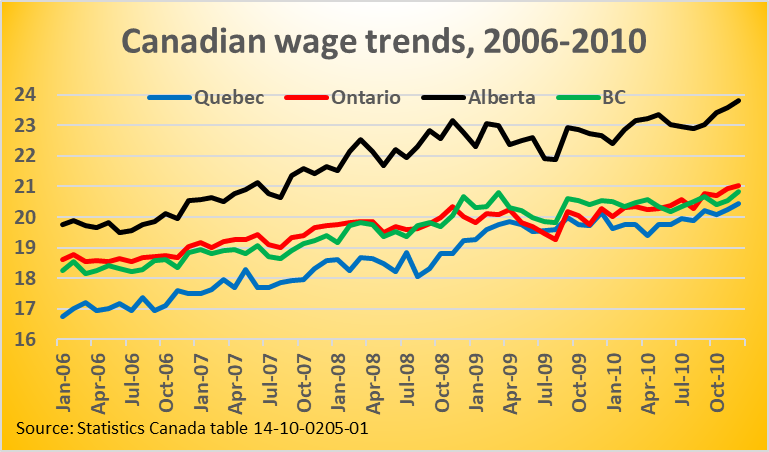BC, Quebec compete for top wage among four big provincial economies
Once the wage king, Ontario is now clear fourth among the major provinces
While Quebec and BC battle it out for top average wage among the four big provincial economies, Alberta and Ontario have fallen from leaders to laggards, according to a long-term analysis of Statistics Canada’s monthly Survey of Employment, Payrolls and Hours.
The most recent SEPH data, released November 28, puts BC on top with an average wage of $31.73 in September, just a few cents ahead of Quebec’s $31.59.
In September, Ontario’s average wage, at $30.19, was $1.54 lower than in BC. On a 2,000 hour workyear, the differences is more than $3,000.
Over 20 years, Ontario has fallen from first to last
Into the early 2000s, Ontario’s economy offered the highest average wage in Canada. But the last time that was true was December 2004 (see charts, below).
From 2003 to 2009, Ontario lost over 20 per cent of its manufacturing jobs, mostly due to a unmanaged appreciation of the Canadian dollar, according to a Bank of Canada analysis.
The Canadian dollar rose from under $0.65 US dollars in 2002 to over $1.06 USD by 2011.
During the same period, Alberta wages boomed as oil prices skyrocketed from $25 per barrel in 2002 to over $100 in mid-2014. During the price boom, Canada received massive capital inflows to build oil sands energy projects, hitting $37 billion in 2014.
The entire budget of Alberta was $43 billion in 2014-15.
Massive oil sands capital investment fell quickly on the dramatic oil price collapse of late 2014. The Canadian dollar, which had drifted from $1.06 USD in 2011 to $0.90 USD in mid-2014, then fell abruptly to $0.75 in the six months ending 2014.
By the end of 2015 the demise of manufacturing jobs left Ontario below BC’s average wage. And after the bust, Alberta’s average wage stagnated through 2016 and 2017 and was eclipsed by BC in spring 2020.
While BC and Quebec moved ahead, Ontario’s average wage entered another period of decline in 2021 and stagnation in 2022, when the Greater Toronto Area started a real estate crash.
Ontario has been been fourth among the four provinces in every month since December 2019 with its average wage in 2022 falling as low as $2.50 below the province placing third of the four.
Challenge of an Ontario turnaround
Higher living costs and lower wages have hurt Ontario consumer spending. Ontario retail sales remain below a 2022 peak although seasonally adjusted retail sales outside Ontario hit new records last month.
How Ontario exits its 20 year decline is a huge challenge to those aspiring to lead Canada’s largest provincial economy and the next Canadian prime minister.








